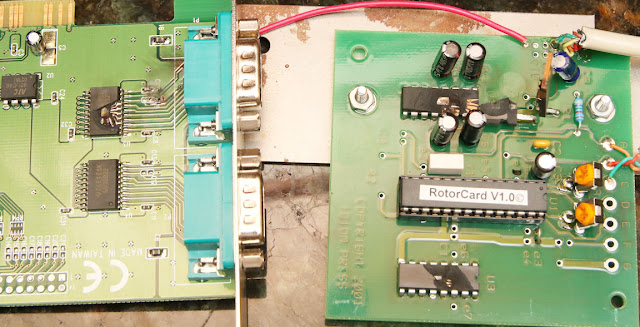Last fall, I had several posts about the lightning strike we suffered (first post - last post). It wasn't a direct hit on the antennas, the tower or the house itself and it took quite a while to understand what happened. A lot of postmortem investigation went on to the best of my ability.
Allow me to present what I think the important points are:
- We saw direct evidence that the lightning hit one of our palm trees located about 25' from the tower and 13' from the front corner of the house. The bark of the tree was split and falling off. Within a month the damage was apparent and within two months the tree was obviously dead.
- There were no blackened spots, no burned or etched spots on the tower or antennas.
- I have four radios attached to a coax switch that eventually ends up at the antennas. The switch has a gas-filled lightning protection tube. None of those four radios had any detectable change to their receivers or transmitters. That would have come through that switch.
- Things on this desktop, in the middle of the house, around 45' from the tree, were blown up if they had a long cable. The cable modem, WiFi router, and other things, were killed immediately. Eventually Mrs. Graybeard's PC degraded to the point where it wouldn't run.
- The most damage in the radio room was to my amplifier, which was plugged into a 240V outlet without a surge protector. The outlet was installed by a "real" electrician within the previous 10 or 12 years, but it's possible that the power line run to that end of the house was lying loose in the attic. Worst case would be lots of wire piled up.
- This leads to the conclusion most of the damage was due to the strike's large currents creating electric and magnetic fields that induced secondary voltages in other wires around the house. For example, the central air conditioner thermostat was connected by a few light wires to the indoor unit around 20' away. The thermostat was blown. The indoor controller for our water heater also died, followed by the water heater itself in November (probably the last thing that failed).
- The only damage to a radio was to the USB interface chip on my main station radio. That was apparently caused by high voltage induced into my rotator controller cable by the strike. The surge then blew out the rotator serial port card I'd added to the controller box. That, then blew up the serial port card in the PC connected to it, somewhere in there it put too much voltage on the USB cable to the radio, blowing out that USB chip and then blew out the power supply in that PC. It is conceivable to me that the computer or the rotator box may have allowed voltage spikes onto the AC power lines.
PC serial port expansion card (left) and rotator serial port card (right). You can see the physically blown parts on both.
Let me begin by saying that I am not a registered professional engineer, a certified electrician, or anyone that you should take advise from. I'm going to talk about some things I've done that I believe are going to help the situation for years to come. I believe I have solid backing for what I'm doing but I have not asked a professional to evaluate it. My station was designed and put together in about 1990. What I'm doing to it is modest changes to improve it, not rebuild it from scratch. Some changes won't involve the station at all. As I understand the rules about electrical inspections, things I don't touch don't need to be brought up to the most recent electrical code, but new installations do.
If you're new to this field or a new ham, I can highly recommend the book “Grounding and Bonding for the Radio Amateur” by H. Ward Silver, N0AX and available from the American Radio Relay League at that link. It's a very well written introduction to these important things, it explains why as much as what, and talks about legal aspects we may need to know.
Since the radios' antenna inputs were well protected by their lightning gas discharge tubes, and most of the things in the house that were plugged into surge protected strips were protected, the task seems to be to protect things with long cables attached. The longest is the 60 or 75 feet of rotor cable that started the path to blowing out my PC and radio.
Next time, a simple way to protect the rotator cable, almost completely built from things I already had.
EDIT 3/14/20 @ 2046 EDT: to lengthen the title. I'm going to search for this some day and the original title just isn't useful enough.

Still waiting for things to thaw and the ground to soften before I get started and finish up the long wire and vertical antennas I put up last year. I have to sink the poles, drive in the ground rods, and drill some holes in the solid-copper ground rod clamps so I mount the PolyPhaser surge protectors.
ReplyDeleteThat is almost like prepping for EMP. Anything with a long cable or wire is toast along with whatever is at the end of the wire or cable.
ReplyDeleteThat's a really good analogy.
DeleteAnd just like an EMP, it can be addressed with filters to keep the undesired stuff out.